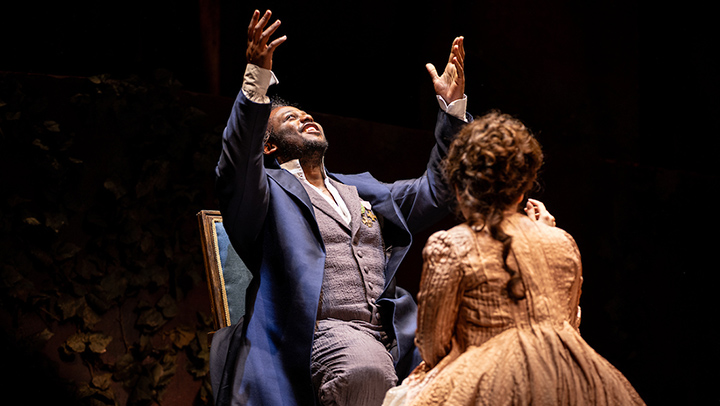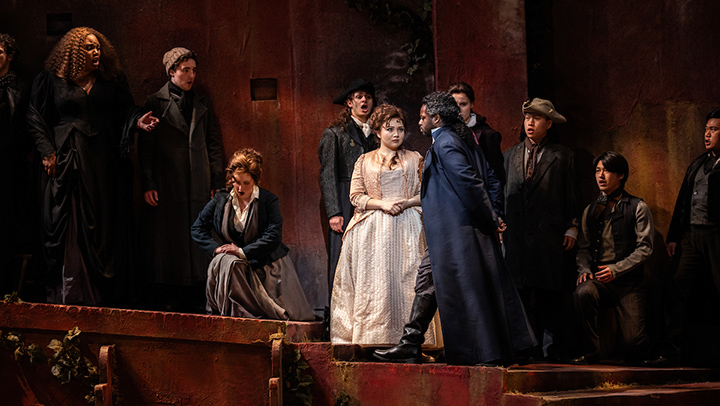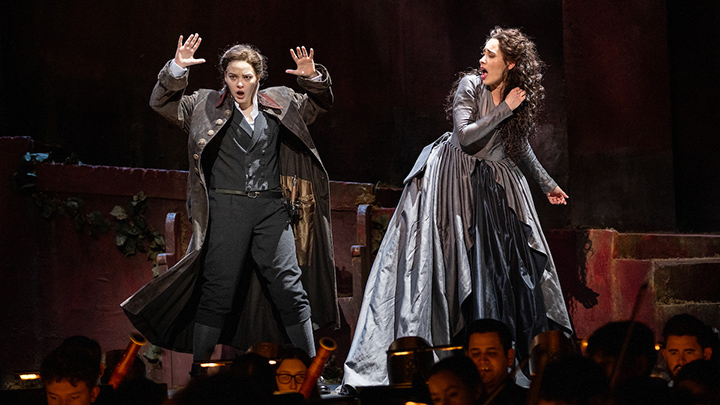Director Stephen Wadsworth’s La Clemenza di Tito for the Juilliard School was a very strange production — strange, in fact, because it was so un-strange. Staid and static, it was a throwback to an older style of staging and largely a waste of an energetic cast of Juilliard students.
The production design depicted the 18th century Europe that produced Clemenza rather than the classical Rome of its ostensible setting. The set, by Charlie Corcoran, comprised an exterior staircase, perhaps the courtyard of a great house, stucco-textured, painted brick red, and dotted with creeping ivy.
A frame around the stage with the Latin names of Emperor and Empress Leopold and Maria indicated the production’s interest in the circumstances under which the opera premiered—as did the program note, by Thomas May, which chronicled the opera’s history as a fairly unsuccessful piece of coronation propaganda.
As a piece of statecraft, Clemenza is indeed rather unsuccessful: messy, ambiguous, at times so naggingly artificial as to seem suspiciously insincere. A production that was interested in the conditions under which it was written, under which this offbeat opera seria presented its perfectly compassionate titular emperor to the emperor who commissioned it—who, by all accounts, disliked it—would be very interesting indeed.
This was not that production. This Clemenza seemed more or less unconcerned with the opera’s political imagination, content to take Tito (Andrew Turner) at his word that his rule is morally enlightened and the citizens at theirs that a benevolent dictatorship is a wonderful thing indeed. This afforded Turner the misfortune of giving him access to only one emotional note—earnestness. The many more musical notes Turner handled well, with a ringing nobility of voice that enlivened the flatness of the staging.
Nor did Wadsworth’s direction do much to imbue the opera’s interpersonal relationships with dramatic weight. Instead, the singers mostly seemed to ape decades-old conventional gestures and stage pictures: the classic move where a diva gets so sad she plasters herself against a wall, the classic pose where a singer stands directly behind her beloved and sings right past her ear, the classic gesture where a singer expresses her love and desire onstage by running her hands up and down her scene partner’s taffeta. People kept dropping to their knees, with varying degrees of motivation. You get the idea.

These gestures were applied seemingly indiscriminately to Ruby Dibble and Evelyn Saavedra as the quarreling lovers Sesto and Vitellia and to Lucy Joy Altus and Shelen Hughes as the harmonious sweethearts Annio and Servillia. This had the unfortunate effect of making both pairs less interesting by lack of contrast.
This was a shame, as the leads sang well—particularly Dibble and Altus in the opera’s two trouser roles. Dibble’s voice was agile and clear, with a steeliness that flashed out when impassioned. Her “Parto, parto,” though conducted at breakneck speed by Nimrod David Pfeffer, had a beautiful emotional ebb and flow. Altus, too, was at her best in a passion, coming out a-blazing for Annio’s “Torna di Tito a lato” aria.
“Blazing,” in fact, was a word that came to mind often; Pfeffer, perhaps attempting to combat the inertness of the blocking, took most tempi tremendously quickly. At times, this propulsiveness was helpful, but, particularly in introspective arias like “Parto, parto,” a slower, more reflective pace would have allowed for more emotional connection.
Hughes’s Servilia sounded lovely, particularly when blending her lighter voice with Altus’s heavier, though similarly sweet, register. As Publio, Shavon Lloyd was, the audience was informed, recovering from illness—but you wouldn’t know it from how assured he sounded.
The only principal, in fact, whose voice gave me pause was Evelyn Saavedra as the tempestuous diva Vitellia. There was something slightly odd about the placement of Saavedra’s voice, which at times had a covered, pinched quality, as if she were struggling to sing out from underneath her own tongue. Still, she was the cast member who most naturally inhabited the production’s grand postures, and she swished her skirts around to beat the band.
Saavedra’s diva grandeur also nicely set up the staging’s most surprising—and therefore interesting—moment: its ambiguous, untriumphant ending. Pardoned by the friend he has betrayed, Hughes as Sesto pushed through a recoiling crowd of onlookers, clearly not ready to trust again, while Saavedra-as-Vitellia fled in tears through the opposite wing, unregarded by the crowd. The noble Sesto, in other words, was tainted by suspicion while the glamorous Vitellia was reduced to a nobody.
These inglorious exits were one of the production’s only moments of skepticism—towards the opera’s political philosophy, towards the opera seria form itself, towards the ending as written. For a brief moment, they evoked a production of La Clemenza di Tito that was more interested in the opera’s strangeness, more willing to be, itself, strange. But by then, it was time for the bows.
Photos: Maria Baranova








Comments